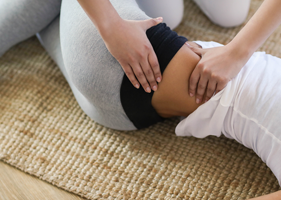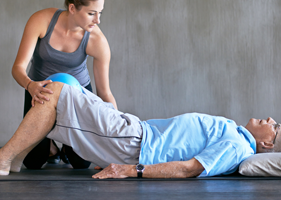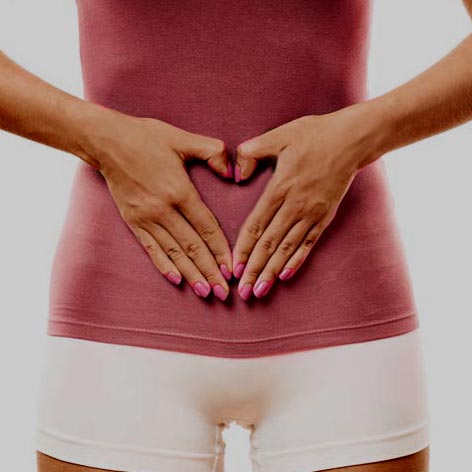 https://santafeobgyn.com/wp-content/uploads/2025/12/pelvic-floor-therapy-santa-.png
200
281
admin
https://santafeobgyn.com/wp-content/uploads/2025/05/l3-santa-fe-obgyn.png
admin2025-11-28 05:08:192025-12-05 05:45:07Pelvic Floor Therapy Improves Circulation, Healing & Hormones
https://santafeobgyn.com/wp-content/uploads/2025/12/pelvic-floor-therapy-santa-.png
200
281
admin
https://santafeobgyn.com/wp-content/uploads/2025/05/l3-santa-fe-obgyn.png
admin2025-11-28 05:08:192025-12-05 05:45:07Pelvic Floor Therapy Improves Circulation, Healing & HormonesPelvic Floor Therapy Stops Embarrassing Incontinence
Bladder leakage affects millions of women, yet the embarrassment surrounding incontinence often prevents women from seeking help. Many believe that urinary leakage is simply a normal part of aging or an inevitable consequence of childbirth. The reality is that incontinence is common, but it is not normal, and effective treatment is available. At Santa Fe OBGYN, we offer specialized pelvic floor therapy with Jacqueline Maestas, DPT, a licensed physical therapist who is certified in pelvic floor therapy. She has helped countless women regain bladder control and get their life back with pelvic floor therapy.
Incontinence can range from occasional light leakage when coughing or sneezing to a sudden, urgent need to reach the bathroom immediately. Some women experience both types of leakage, which can significantly impact quality of life. The fear of an accident may cause women to avoid exercise, social activities, or travel. Many find themselves constantly scanning for bathroom locations or wearing protective pads daily. This does not have to be your reality.
Pelvic floor therapy offers a proven, non-surgical approach to treating incontinence by addressing the underlying muscle weakness or dysfunction that allows leakage to occur. Rather than simply managing symptoms with pads or medications, this therapy strengthens and retrains the muscles responsible for bladder control, providing long-lasting results without surgery or drugs.
Understanding Pelvic Floor Therapy for Bladder Control
Pelvic floor therapy is a specialized form of physical therapy that targets the muscles, nerves, and connective tissues supporting the bladder, uterus, and bowel. These muscles play a critical role in maintaining continence by supporting pelvic organs and controlling the opening and closing of the urethra. When pelvic floor muscles become weak, overstretched, or uncoordinated, they cannot effectively prevent urine leakage during activities that increase abdominal pressure.
Treatment with Jacqueline Maestas, DPT at Santa Fe OBGYN begins with a comprehensive evaluation to determine the specific type and cause of incontinence. This assessment includes examining pelvic floor muscle strength, endurance, coordination, and the ability to properly contract and relax these muscles. Many women are surprised to learn they have been performing pelvic floor exercises incorrectly for years, which explains why their symptoms have not improved. Proper technique is essential for results.
Pelvic floor therapy sessions are conducted privately and professionally, with treatment customized to each woman’s needs. Therapy may include manual techniques to release tight muscles or scar tissue, specific exercises to strengthen weak muscles, biofeedback to improve muscle awareness and control, and behavioral strategies to improve bladder habits. Most women notice improvement within several weeks, with continued progress throughout the treatment course.
What Causes Incontinence in Women
Understanding the causes of incontinence helps explain why pelvic floor therapy is so effective. The most common type affecting women is stress urinary incontinence, which occurs when physical activity or pressure on the bladder causes leakage. This happens when the pelvic floor muscles and urethral sphincter are too weak to withstand the pressure created by coughing, sneezing, laughing, jumping, or lifting. Pregnancy and vaginal childbirth are leading causes of stress incontinence, as the weight of the baby and the stretching during delivery can weaken or damage pelvic floor muscles and nerves.
Urge incontinence, also called overactive bladder, involves a sudden, intense urge to urinate followed by involuntary leakage. This occurs when the bladder muscle contracts inappropriately, often triggered by certain sounds, positions, or situations like putting a key in the door. While the exact cause is not always clear, pelvic floor dysfunction, nerve damage, urinary tract infections, and certain neurological conditions can contribute to urge incontinence.
Many women experience mixed incontinence, a combination of both stress and urge symptoms. Hormonal changes during menopause can worsen incontinence as declining estrogen levels cause vaginal and urethral tissue thinning, reducing support for the bladder. Chronic coughing from smoking or lung conditions, obesity, chronic constipation, and previous pelvic surgeries also increase the risk of developing incontinence. According to the National Institutes of Health, certain medications including diuretics, sedatives, and some blood pressure medications can contribute to bladder control problems.
How Common Is Incontinence Among Women
Incontinence is remarkably common, though many women suffer silently without realizing how many others share their experience. According to the National Association for Continence, approximately twenty-five million Americans experience some form of urinary incontinence, with women twice as likely as men to develop this condition. Research published by the American Urological Association indicates that up to fifty percent of adult women experience urinary leakage at some point in their lives.
The prevalence increases with age, but incontinence affects women across all age groups. Studies show that approximately one in three women over age thirty experience incontinence symptoms, while more than half of women over sixty-five deal with bladder leakage. Younger women, particularly athletes and new mothers, also commonly experience stress incontinence. A study in the International Urogynecology Journal found that up to thirty-five percent of female athletes report urinary leakage during their sport.
Despite how widespread incontinence is, research indicates that only one in four women with symptoms seeks treatment. Many women wait an average of six to eight years before discussing incontinence with a healthcare provider, often believing that nothing can be done or that symptoms are not severe enough to warrant treatment. This delay is unfortunate because pelvic floor therapy is most effective when initiated early, before patterns become deeply ingrained and before muscle weakness progresses.
How Pelvic Floor Therapy Helps Stop Incontinence
Pelvic floor therapy treats incontinence by strengthening weak muscles, improving muscle coordination, and retraining bladder habits. For women with stress incontinence, the primary focus is strengthening the pelvic floor muscles so they can better support the bladder and maintain urethral closure during activities that increase abdominal pressure.
As part of our pelvic floor therapy, Jacqueline Maestas, DPT teaches proper technique for pelvic floor muscle exercises, often called Kegels, ensuring women engage the correct muscles with appropriate intensity and duration. Many women have been performing Kegel exercises incorrectly, using abdominal, buttock, or thigh muscles instead of isolating the pelvic floor. During therapy sessions, Jacqueline Maestas, DPT uses biofeedback technology to provide visual or auditory confirmation that muscles are contracting properly. This real-time feedback dramatically improves learning and ensures women can perform exercises correctly at home for maximum benefit.
For stress incontinence, therapy includes training what is called “the knack,” a technique where women learn to consciously contract their pelvic floor muscles just before and during activities that typically cause leakage, such as coughing or jumping. This preemptive contraction prevents leakage by providing extra support to the urethra at the moment pressure increases. With practice, this becomes automatic, allowing women to exercise and go about daily activities without fear of leakage.
Treatment for urge incontinence focuses on bladder retraining and calming overactive bladder muscles. Jacqueline Maestas, DPT teaches specific techniques to suppress the urge to urinate, including pelvic floor muscle contractions, breathing exercises, and mental strategies. Women learn to gradually increase the time between bathroom visits, retraining the bladder to hold more urine and respond appropriately to filling. Identifying and modifying dietary triggers like caffeine, artificial sweeteners, and acidic foods often reduces urgency and frequency.
Addressing other contributing factors is also important. If constipation is present, strategies to improve bowel regularity reduce pressure on the bladder. If excess weight contributes to leakage, education about the impact of weight loss on symptoms provides motivation. If chronic coughing from smoking is a factor, resources for smoking cessation are discussed. This comprehensive approach addresses all factors contributing to incontinence rather than focusing solely on muscle strength.
Why See a Certified Pelvic Floor Therapist for Incontinence
Not all physical therapists are trained in pelvic floor therapy, and certification in this specialty is essential for effective treatment of incontinence. Jacqueline Maestas, DPT has completed advanced training specifically in pelvic floor dysfunction and holds certification in pelvic floor therapy, demonstrating expertise in this specialized area. Her extensive knowledge of pelvic anatomy, muscle function, and evidence-based treatment protocols ensures women receive the highest quality care.
At Santa Fe OBGYN, pelvic floor therapy is provided within a comprehensive women’s health practice. This integration allows Jacqueline Maestas, DPT to collaborate closely with board certified OBGYN Dr. Lynore Martinez, MD and the entire medical team. If hormonal issues, urinary tract infections, prolapse, or other conditions contribute to incontinence, these can be diagnosed and treated concurrently with pelvic floor therapy. This coordinated approach produces better outcomes than addressing muscle dysfunction alone.
The effectiveness of pelvic floor therapy for incontinence is well-established in medical literature. According to the American Urogynecologic Society, pelvic floor muscle training is considered first-line treatment for stress urinary incontinence, with success rates of sixty to seventy-five percent for motivated patients who complete their treatment program. Studies published in the Journal of Urology have shown that properly performed pelvic floor therapy can reduce incontinence episodes by more than fifty percent in many women, with some achieving complete dryness.
Pelvic floor therapy at Santa Fe OBGYN is personalized to each woman’s specific symptoms, lifestyle, and goals. Some women achieve significant improvement within six to eight weeks, while others with more severe symptoms may benefit from longer treatment courses. Throughout therapy, Jacqueline Maestas, DPT provides encouragement and support, helping women stay motivated and tracking progress to demonstrate improvement. The compassionate, professional environment at Santa Fe OBGYN makes discussing sensitive symptoms comfortable and ensures women feel supported throughout their recovery.
Pelvic Floor Therapy | Santa Fe
Living with incontinence means missing out on activities you love and constantly worrying about embarrassing leaks. You deserve better than managing symptoms with pads and bathroom mapping. Pelvic floor therapy at Santa Fe OBGYN with Jacqueline Maestas, DPT offers real solutions that address the root cause of bladder leakage and restore your confidence. Whether you experience leakage with exercise, sudden urges, or both, specialized treatment can help you regain bladder control and get back to living life without limitations. Take the first step toward freedom from incontinence and schedule a pelvic floor therapy consultation at Santa Fe OBGYN today.
Santa Fe Pelvic Floor Therapy: 505-988-4922
Thanks For Visiting Our Blog
Thank you for visiting the Live Well Blog, where we keep our patients up-to-date on the latest developments, news, research, and technology in the field of natural medicine. Here you will find information to naturally support & heal your body, so you can engage in your life purpose of connection and emotional and spiritual growth. Please check back often as we add new information that can help you live a longer, happier, and healthier life.












